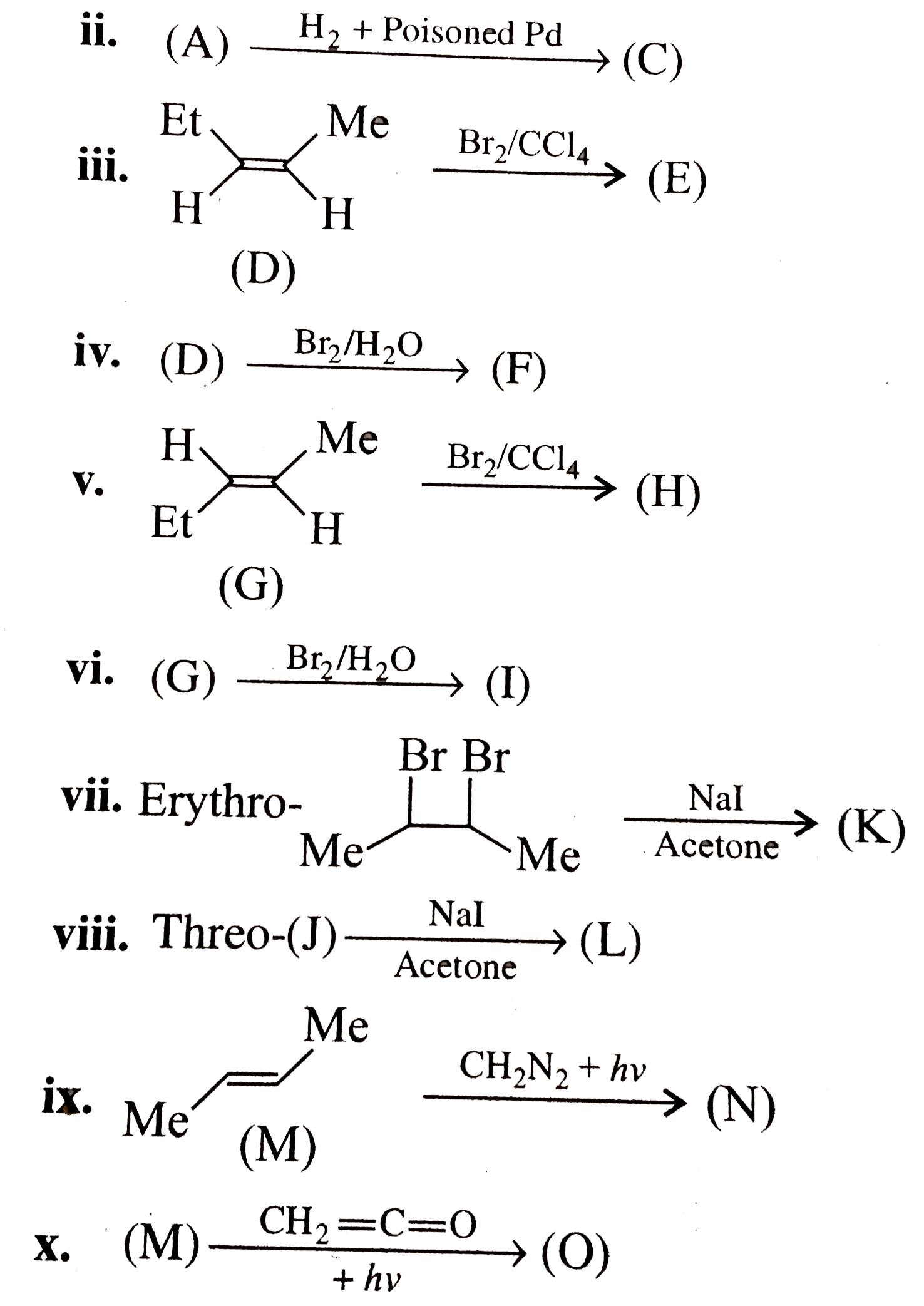K2[Ni(CN)4]K in liq.−−−−→NH3X'
Regarding this reaction correct statement is/are:
X' is K4[Ni(CN)4]
The oxidation state of Ni changed +2 to zero
The structure of 'X' is tetrahedral
[Ni(CN)4]2− is square planar complex
The correct Answer is:A, B, C, D
To solve the question regarding the reaction of K2(Ni(CN)4) in the presence of liquid ammonia and potassium ions, we will follow these steps:
Step 1: Identify the Reactants
The reactant is K2(Ni(CN)4). This is a coordination compound where nickel (Ni) is coordinated to four cyanide (CN) ligands. The oxidation state of nickel in this complex is +2.
Step 2: Determine the Reaction Conditions
The reaction occurs in the presence of liquid ammonia (NH₃) and potassium ions (K⁺). The presence of NH₃, a strong field ligand, can lead to the formation of a new complex.
Step 3: Predict the Product
When K2(Ni(CN)4) reacts with NH₃, it forms a new complex, which we denote as X. The resulting complex is likely K4(Ni(CN)4) due to the addition of NH₃ ligands.
Step 4: Calculate the Oxidation State of Nickel in the Product
In the new complex K4(Ni(CN)4), we need to determine the oxidation state of nickel:
- The overall charge of the complex is neutral.
- The cyanide ligands (CN⁻) contribute a total charge of -4 (since there are four CN⁻ ligands).
- The potassium ions (K⁺) contribute a total charge of +4 (since there are four K⁺ ions).
Thus, the oxidation state of nickel (Ni) can be calculated as follows:
Oxidation state of Ni+4(−1)+4(+1)=0
Oxidation state of Ni−4+4=0
Oxidation state of Ni=0
Step 5: Determine the Geometry of the New Complex
The geometry of the new complex K4(Ni(CN)4) can be predicted based on the hybridization of the nickel ion:
- Nickel in the +0 oxidation state has the electronic configuration of (Ar)4s23d8.
- The strong field nature of CN⁻ causes pairing of electrons, leading to the hybridization of sp3.
- Therefore, the geometry of the complex is tetrahedral.
Step 6: Verify the Geometry of the Initial Complex
For the initial complex K2(Ni(CN)4):
- The oxidation state of nickel is +2.
- The electronic configuration for Ni²⁺ is (Ar)3d8.
- The hybridization is dsp2, which corresponds to a square planar geometry.
Conclusion
Based on the analysis:
1. The oxidation state of nickel changes from +2 in K2(Ni(CN)4) to 0 in K4(Ni(CN)4).
2. The geometry of the new complex K4(Ni(CN)4) is tetrahedral.
3. The initial complex K2(Ni(CN)4) has a square planar geometry.
Final Statements
- The oxidation state of nickel changes from +2 to 0.
- The geometry of the product X is tetrahedral.
- The geometry of the initial complex is square planar.
The reactant is K2(Ni(CN)4). This is a coordination compound where nickel (Ni) is coordinated to four cyanide (CN) ligands. The oxidation state of nickel in this complex is +2.
The reaction occurs in the presence of liquid ammonia (NH₃) and potassium ions (K⁺). The presence of NH₃, a strong field ligand, can lead to the formation of a new complex.
When K2(Ni(CN)4) reacts with NH₃, it forms a new complex, which we denote as X. The resulting complex is likely K4(Ni(CN)4) due to the addition of NH₃ ligands.
In the new complex K4(Ni(CN)4), we need to determine the oxidation state of nickel:
- The overall charge of the complex is neutral.
- The cyanide ligands (CN⁻) contribute a total charge of -4 (since there are four CN⁻ ligands).
- The potassium ions (K⁺) contribute a total charge of +4 (since there are four K⁺ ions).
Oxidation state of Ni+4(−1)+4(+1)=0
Oxidation state of Ni−4+4=0
Oxidation state of Ni=0
The geometry of the new complex K4(Ni(CN)4) can be predicted based on the hybridization of the nickel ion:
- Nickel in the +0 oxidation state has the electronic configuration of (Ar)4s23d8.
- The strong field nature of CN⁻ causes pairing of electrons, leading to the hybridization of sp3.
- Therefore, the geometry of the complex is tetrahedral.
For the initial complex K2(Ni(CN)4):
- The oxidation state of nickel is +2.
- The electronic configuration for Ni²⁺ is (Ar)3d8.
- The hybridization is dsp2, which corresponds to a square planar geometry.
Based on the analysis:
1. The oxidation state of nickel changes from +2 in K2(Ni(CN)4) to 0 in K4(Ni(CN)4).
2. The geometry of the new complex K4(Ni(CN)4) is tetrahedral.
3. The initial complex K2(Ni(CN)4) has a square planar geometry.
- The oxidation state of nickel changes from +2 to 0.
- The geometry of the product X is tetrahedral.
- The geometry of the initial complex is square planar.
Topper's Solved these Questions
- CO-ORDINATION COMPOUNDSBOOK - VK JAISWAL ENGLISHCHAPTER - CO-ORDINATION COMPOUNDSEXERCISE - MATCH THE COLUMN
36 Videos
- CO-ORDINATION COMPOUNDSBOOK - VK JAISWAL ENGLISHCHAPTER - CO-ORDINATION COMPOUNDSEXERCISE - ASSERTION-REASON TYPE QUESTIONS
26 Videos
- CO-ORDINATION COMPOUNDSBOOK - VK JAISWAL ENGLISHCHAPTER - CO-ORDINATION COMPOUNDSEXERCISE - LEVEL 3 (PASSAGE TYPE)
98 Videos
- CHEMICAL BONDING (BASIC)BOOK - VK JAISWAL ENGLISHCHAPTER - CHEMICAL BONDING (BASIC)EXERCISE - SUBJECTIVE PROBLEMS
54 Videos
- d-BLOCK ELEMENTSBOOK - VK JAISWAL ENGLISHCHAPTER - d-BLOCK ELEMENTSEXERCISE - ASSERTION-REASON TYPE QUESTIONS
32 Videos
Similar Questions
Knowledge Check
CH3CH2C≡CHNaNH2−−−−−→liq. NH3I

Product (K) of the above reaction is :A B
B C
C D
D
CrCl3NH4Cl−−−−→NH4OH(A)Na2O2−−−→H2O(B)Lead−−−→acetate(C)
In this reaction sequence, the compound (C) is:
View SolutionConsider of following reactions
CHF3Ka−−→CF−3+H+
CHCl−3K+a−−→CCl−3+H+
Then regarding given reactions which of the following statement(s) is /are correct:
View SolutionC3H2=2C=1CH2Propa-1,2-diene(A)NaNH2+Liq.NH3−−−−−−−−−−−→(B)
Which of the following statements is / are correct ?
View SolutionA proposed mechanism for a reaction A→B is
Ak1⇐⇒k2C Ck3⇐⇒k4B
Determine the expresison for the equilibrium constant for the overall reaction in terms of the rate constants.
View SolutionH3C−C≡C−CH3Na/Liq.NH3−−−−−−−−→X In the above reaction X is
View SolutionMeCOOEt(i)NH2NH2−−−−−−−→(ii)HNO2(iii)ΘOH(B)−−−→MeOH(C)
Which of the following statements are correct about the given reaction?
View SolutionConsider the following reactions :
IMe−≡(A)−MeNa+Liq.NH3−−−−−−−−→EtOH(B)
 .
.
Which statement is wrong about the reactions (ix) and (x) ?
View Solution
